You have just subscribed to Verizon Fios fiber internet, you’ve got your new Fios router, and you cannot be happier with the speeds that you are getting. However, the range is not the best – you have one or several dead spots, and you’re now looking for a solution. The most convenient solution is getting a wi-fi extender for Fios router.
You can rent a new Fios extender from Verizon ($10/month), you can buy it from Verizon ($199), or you can buy a third-party wi-fi extender. We are here to discuss these options, analyze differences between extenders, repeaters, access points, and mesh systems, tell you what to look for, what wi-fi extenders work with Fios, and explain how to set up a wi-fi extender for Fios router.
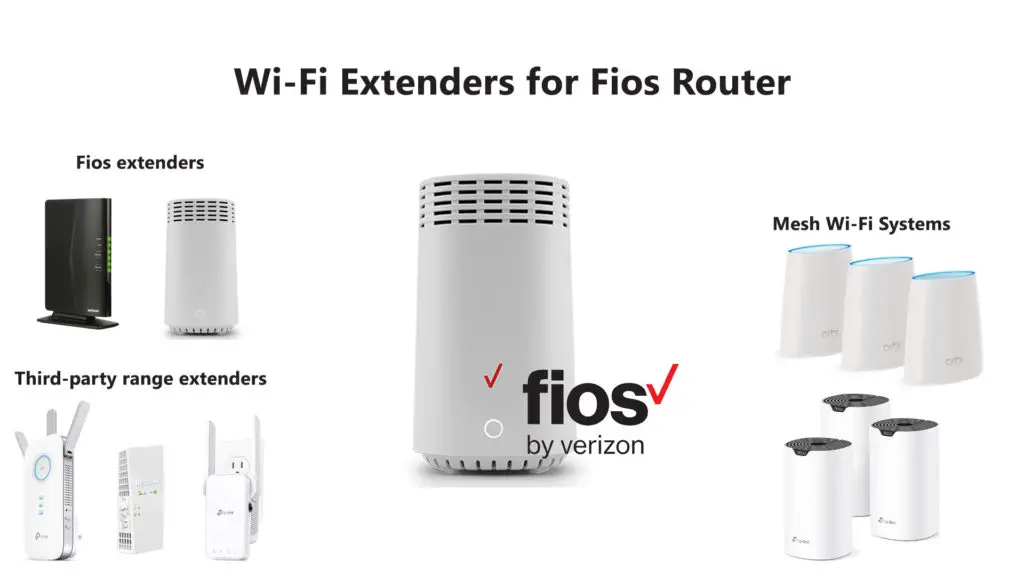
CONTENTS
- What is a Wi-Fi Extender?
- What’s the Difference Between a Wi-Fi Extender, Wi-Fi Repeater, and a Wi-Fi Booster?
- What’s the Difference Between a Wi-Fi Extender and a Mesh System?
- Things to Consider Before Even Thinking About Buying a Wi-Fi Extender for Fios Router
- Verizon Fios Extenders
- Do All Third-Party Wi-Fi extenders work with Fios router?
- What Should I Look For – Wi-Fi Mesh System or Wi-Fi Extender for Fios Router?
- Best Wi-Fi Extenders for Fios Router
- 1. Best Cheap Wi-Fi Extender for Fios Router – TP-Link RE230
- 2. Best Budget Wi-Fi Extender for Fios Router – NETGEAR EX2800
- 3. Best Wi-Fi Extender for Fios Router Under $100 – NETGEAR EX7000
- 4. Best Powerline Ethernet Extender for Fios Router – TP-Link TL-PA7017
- 5. Best Powerline Wi-Fi Extender for Fios Router – NETGEAR PLW1010
- 6. Best Wi-Fi Extender for Fios Router Under $150 – TP-Link RE650
- Best Wi-Fi Mesh Systems for Fios Router
- 7. Best Budget Wi-Fi Mesh System for Fios – TP-Link Deco S4
- 8. Best Wi-Fi Mesh System fir Fios Router Under $500 – Amazon eero Pro mesh
- 9. Best Wi-Fi Mesh System for Fios Route Under $1,000 – NETGEAR Orbi RBK853
- FAQ
What is a Wi-Fi Extender?
The name already says it all. It extends your existing wi-fi network allowing you to get wi-fi coverage in areas that used to be dead zones. They connect to your wi-fi network and then create an access point that rebroadcasts the signal received from your router.
There are different types of extenders. They use different technologies to deliver the same result – extend your wi-fi coverage. We can divide all range extenders into three categories – wi-fi extenders, powerline Ethernet extenders, and hybrid extenders (aka wi-fi powerline extenders).
Wi-Fi Extenders
Most extenders on the market are wi-fi extenders. They receive the signal from your router, either wirelessly or via Ethernet cable, create a new wi-fi network, and rebroadcast the signal received from the router.
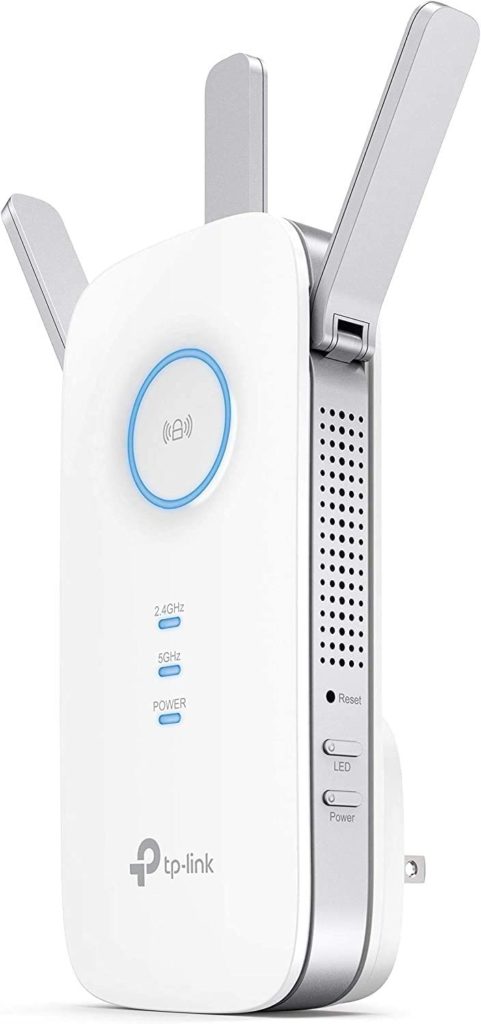
TP-Link RE450 Wi-Fi extender
Powerline Extenders
Powerline extenders also extend the range and receive the signal from your router, but they receive it through your existing electrical installations.
While you can have just one wi-fi extender, a powerline extender consists of two units – sender and receiver (you can’t just send the signal directly from the router). The sender has to be installed close to your router (and has to be connected to your router via Ethernet cable), while the receiver can be placed wherever you need it.
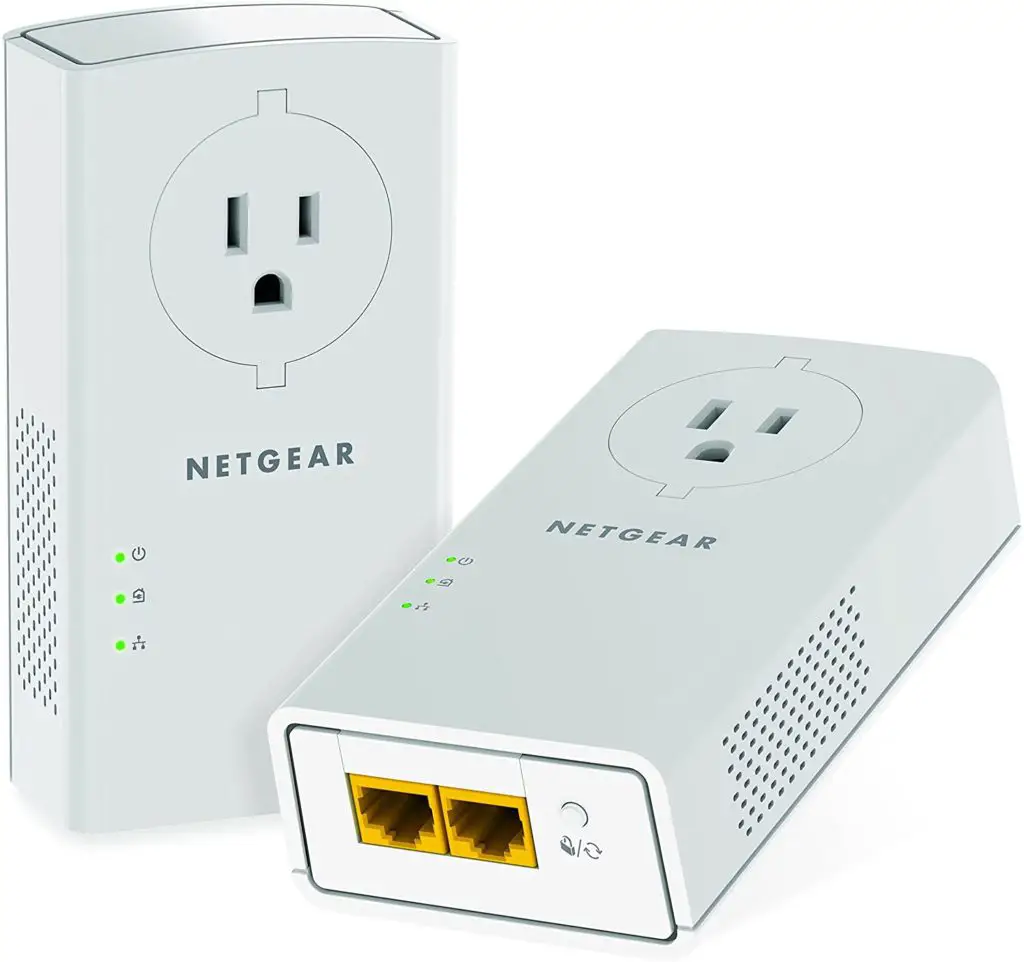
NETGEAR PLP2000 powerline extender kit (sender/receiver)
Unfortunately, powerline extenders don’t create a new wi-fi network allowing you to connect wireless devices. Instead, the receiver units have one, two, or more RJ-45 ports allowing you to connect devices via Ethernet cable.
So, traditional powerline adapters are a good choice if you want to connect desktop computers, laptops, smart TVs, gaming consoles, and other devices with an Ethernet port. On the other hand, powerline adapters are not a good choice if you want to connect devices that only support wireless connection.
Hybrid Extenders (Powerline Wi-Fi Extenders)
Hybrid extenders are a combination of wi-fi extenders and powerline extenders. You still have two units (sender and receiver), and the signal/data is still sent through electrical installations. The sender unit is the same as the one that comes with a traditional powerline extender, while the receiver unit has a built-in radio and can broadcast the wi-fi signal.
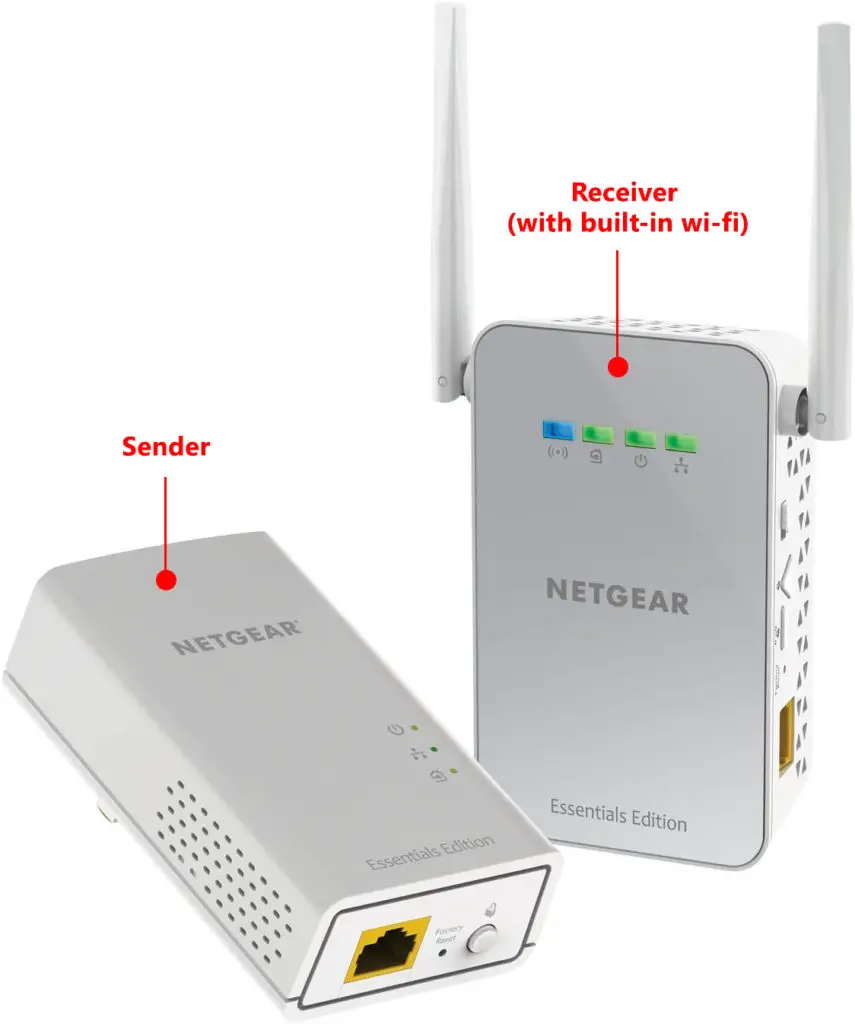
NETGEAR PLW1010 hybrid wi-fi extender kit
What’s the Difference Between a Wi-Fi Extender, Wi-Fi Repeater, and a Wi-Fi Booster?
Terms like wi-fi repeater, wi-fi extender, wi-fi booster, and wi-fi access point create a lot of confusion among customers. The first three terms are often used interchangeably, and not just by the regular people, but also by the manufacturers. So, are they the same thing or not?
Some sources argue that there’s a difference between wi-fi extenders and wi-fi repeaters. Namely, they claim that wi-fi extenders require a wired connection to the router (via Ethernet cable). So, according to these sources, you have to run an Ethernet cable from your router to the place you want to plug your wi-fi extender in. So, the extender receives the signal via Ethernet cable, and then creates its own wi-fi network and broadcasts the signal. Wi-Fi repeaters, on the other hand, can be installed without an Ethernet cable. You just have to plug them in and connect them wirelessly to the router – they will receive the signal wirelessly, and then rebroadcast that signal.
We don’t agree with this claim. At least, not completely. Here’s the thing – to receive the signal via Ethernet cable, a wi-fi extender must support an access point mode (access points connect to routers via Ethernet cable and then rebroadcast the wi-fi signal). All the devices that are advertised as wi-fi range extenders that support the access point mode also support the repeater mode. So, I guess we could say that all the wi-fi range extenders are wi-fi repeaters, but not all wi-fi repeaters are wi-fi extenders.
Recommended reading :
- What Modems Are Compatible With Comcast Xfinity?
- What Modems Are Compatible With Suddenlink?
- What Modems Are Compatible With Windstream?
Using a wi-fi extender in a repeater mode is more convenient because you don’t have to think about wiring. However, the speeds you’ll get will be significantly lower compared to the speeds you would get when your PC/laptop/phone is connected directly to the router (either wirelessly or via Ethernet cable).
Setting up your wi-fi extender in access point mode is much harder because you have to run the Ethernet cable (assuming that your home is not pre-wired), but you will get much better bandwidth and higher speeds – it is basically the same as connecting your device directly to your router.
Wi-Fi booster is a generic term used to describe both wi-fi extenders and wi-fi repeaters. We spent hours trying to find some meaningful explanation that would help us understand the difference between extenders and repeaters on one hand, and wi-fi boosters on the other hand, but we didn’t find any. So, our conclusion is that wi-fi booster is just a marketing term.
What’s the Difference Between a Wi-Fi Extender and a Mesh System?
Wi-Fi extenders and wi-fi mesh systems are both used to improve wi-fi coverage and range, but there’re some important differences between these devices. Based on your requirements and budget, you’ll opt for one or the other solution.
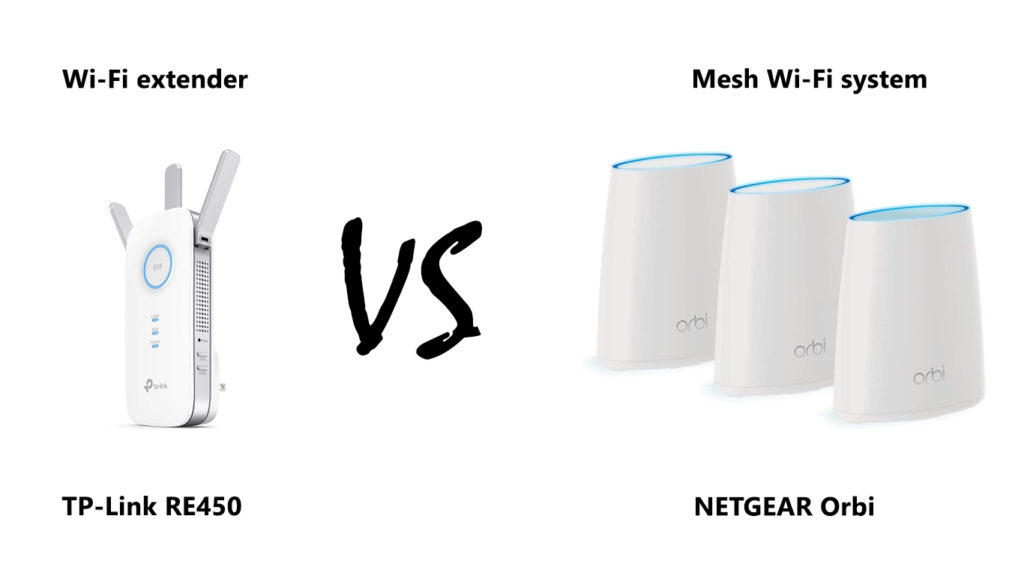
Extenders are, for starters, a much cheaper option. They are a good choice if you live in a small apartment/house with a single or maybe two dead zones.
Mesh systems are much more expensive, especially good mesh systems. While extenders are single units, mesh systems are kits that consist of one router and one, two, or multiple satellites. So, if you opt for a mesh system, you will also have to replace your old router with a new mesh router (or to disable the router portion of your gateway).
Mesh systems, in general, are a smarter choice for large homes because they provide better wi-fi coverage and better speeds than wi-fi extenders.
So, it’s all about making balance. If you have the money and live in a large house, you should probably go for a mesh system. If you live in a small apartment with just one dead spot, a wi-fi extender is a more cost-efficient solution and will deliver satisfying performance.
Things to Consider Before Even Thinking About Buying a Wi-Fi Extender for Fios Router
In some cases, you can solve your wi-fi coverage issues without using a wi-fi extender.
Basic troubleshooting
Every router comes with a user manual, and in every user manual, there’s a chapter dedicated to router placement. The general guidelines are:
- Pick the central spot in your apartment – you can’t put your router in the basement and expect it to spread the signal all the way to the attic.
- Placing it out in the open is desirable; placing it in corners, surrounded by walls, is not.
- Higher positions are better than placing it on the ground
So, our advice is to try repositioning the router. It can be tricky, especially if you have to run the Ethernet cable through walls, but it could solve your problem.
Using an old router as a Wi-Fi extender for Fios
If you don’t want to move your router, whether because it’s located in your home office or for some other reason, you still have some options available before buying a wi-fi extender for Fios router. If you have an old router that you don’t use, you may be able to set it up as an extender/repeater or an access point.
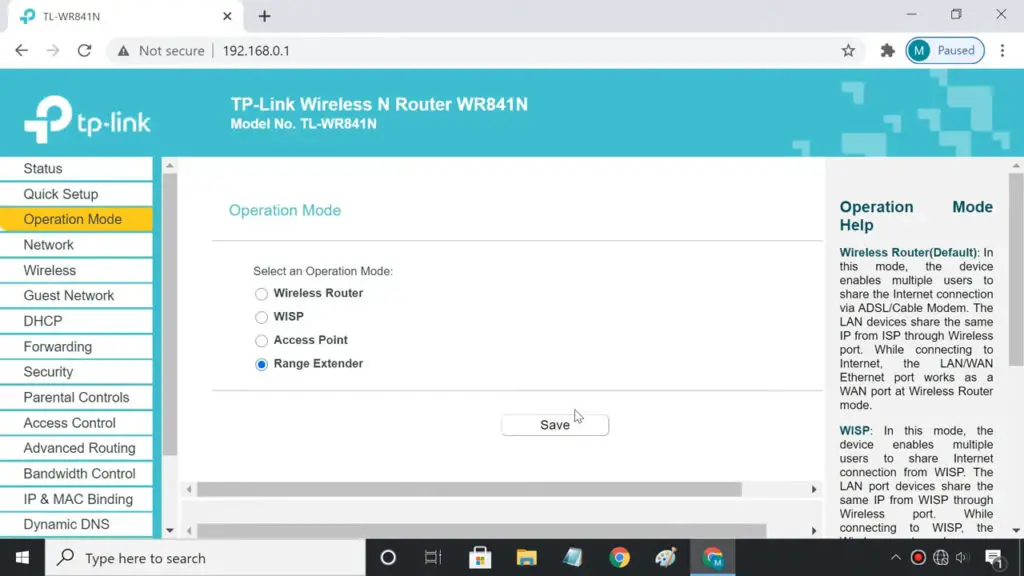
Our routers, even old ones, are versatile devices. While router mode is their primary operation mode, many routers can also be used in other modes. For example, they can be used as access points or repeaters. The only problem is that older routers are rarely dual-band. Most of them are not even WiFi5 routers. Still, they will do the most important job – they will extend your wi-fi range and deliver internet to dead zones of your house. So, if you want to save money and don’t need spectacular performance, this is a viable solution.
VIDEO TUTORIAL – Using a TP-Link router in extender/repeater mode
https://www.youtube.com/watch?v=EFEZIyQ-eA0
If you don’t have an old router somewhere in your basement, or if you want the best possible performance with dual-band wi-fi, higher capacity, and higher speeds, then you have no other option but to buy a wi-fi extender for Fios router. But even here, you have more than one option. Let’s discuss your options.
Verizon Fios Extenders
The easiest thing to do is rent or buy the wi-fi extender directly from Verizon. They are the easiest to install and integrate with your other Fios services (like Fios TV ONE). There are three extenders that are currently in use.
The latest one is Fios Extender E3200. This one will only work with the latest Fios router G3100. Then, you have a dual-band WCB6200Q Fios Network extender. This one will work with Fios Quantum Gateway and Fios Advanced wi-fi router. The oldest model that is still in use is WCB3000N – this is a single-band network extender and it’s also compatible with older Fios routers.
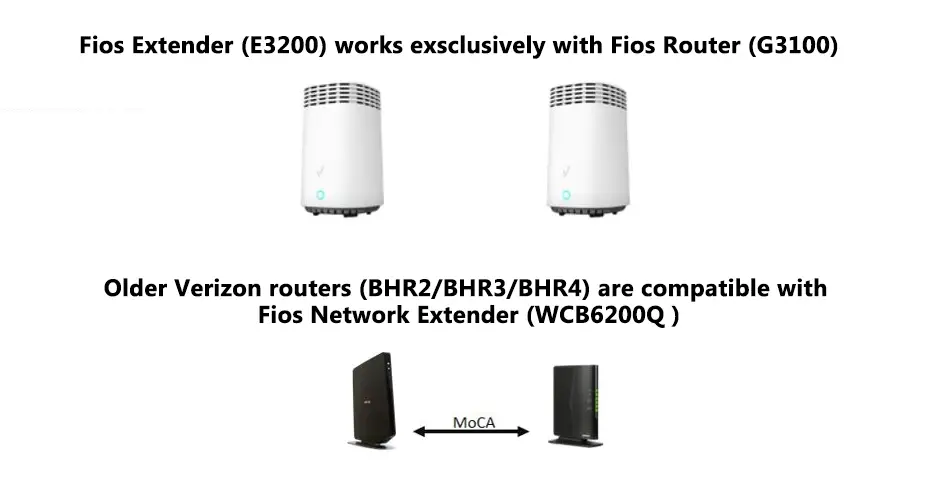
Renting an extender from Fios will cost you $10/month. You can also buy E3200 for $200. The older WCB6200Q will cost you $120.
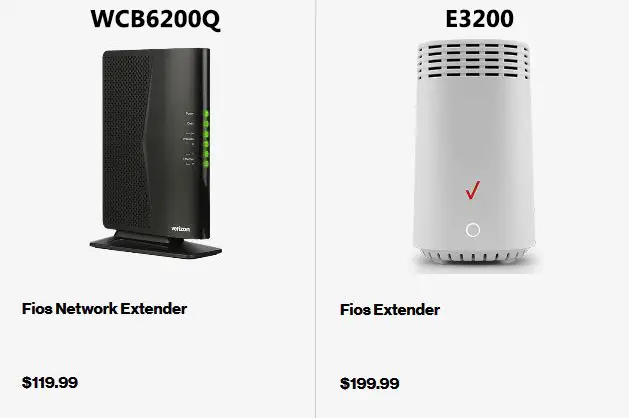
Verizon Fios routers and extenders are a much more convenient solution and much easier to install, especially if you’re also subscribed to Fios TV and are using Fios TV ONE box. If you just have Fios internet, installing your own Fios compatible router or range extender is not a huge hassle.
When you also have Fios TV ONE, and when you want your Fios ONE box to communicate with the router or extender wirelessly, you must use the equipment provided by Verizon. You see, the Fios router and Fios Extender (E3200) create a dedicated (but hidden) 5G network for Fios ONE, while third-party routers and extenders don’t do that.

The problem with Fios ONE boxes and Fios TV is that these services rely heavily on communication with the Fios router. Some customers have managed to activate most of the TV services using third-party routers, but that required using additional equipment (old Verizon Fios router or MoCA adapter) and some adjustments to the network settings. So, using a third-party router and extenders is possible even when you are subscribed to Fios Tv, but it’s not an easy thing to do, and it will still require some occasional troubleshooting and network adjustments.
Do All Third-Party Wi-Fi extenders work with Fios router?
As discussed in the previous section, if you just have Fios internet, using a third-party router or wi-fi extender for Fios router, should not be an issue. You can even buy a wi-fi mesh system, and use the system instead of the Fios router and Fios Extender.
If you are also subscribed to Fios TV/Fios TV ONE and want to keep using the Fios router, but you also want to buy a third-party extender for Fios router, you will get internet but your ONE box (or boxes) won’t be able to communicate with the extender via wi-fi (but they will be able to communicate with the Fios router if they are within range).
Mesh systems will also work with Fios internet. If you opt for a mesh system, you can return your Fios router, and use just this system. You will connect the main unit to the Fios ONT (the main unit will replace your Fios router), and then connect the mesh satellites to the main unit. So, instead of spending $500 on a Fios router and Fios extender, you can buy a cheaper mesh system with two extenders. Or you can spend the same amount of money and buy anything you like. The other option is to keep your Fios router – connect the main mesh unit (mesh router) to the Fios router and set it up in access point mode. Then, connect the mesh satellites to the mesh router.
Again, using Fios Tv ONE box with a third-party mesh system will be tricky because it relies on wireless communication with the Fios router over a hidden 5G wi-fi network, but It’s doable. Using a mesh wi-fi system with Fios TV is the same as using your non-Verizon router with Fios TV. Watch the video below for instructions.
Using a third-party router (or a mesh wi-fi system) with Fios internet and Fios TV
What Should I Look For – Wi-Fi Mesh System or Wi-Fi Extender for Fios Router?
As discussed, both types of devices have their advantages and disadvantages. The most important advantage of extenders is that they are cheaper. You can get a decent extender that supports both – repeater and AP mode for $30-$50. There are also higher-quality extenders that cost up to $100. The problem with cheap extenders (when used in repeater mode), is that they cut the bandwidth (your internet speed) in half, or even more. That’s because cheaper units use just one radio to communicate with the router and with the devices. More expensive units may have two radios, which improves the performance and bandwidth, but you still can’t expect the same speeds you would get by connecting your device directly to the router.
Mesh systems, in general, deliver better performance than range extenders (repeaters). Mesh routers use a dedicated wi-fi signal to communicate with their satellites, which means that they don’t affect the bandwidth/speeds as much as wi-fi extenders. Verizon Fios router and Verizon Extender are basically a mesh wi-fi system.
Mesh systems are a better choice for large homes with multiple dead spots. The biggest problem with wi-fi mesh systems is their price (up to $1,000 for a 3-piece kit).
Now that you know a lot more about wi-fi extenders and similar devices that can extend the range of your wi-fi, you can hopefully make an informed decision, and choose the type of device that’s perfect for your needs. If you are looking for suggestions, check out our selection of the best wi-fi extenders for Fios router. Our selection consists of two parts – best wi-fi extenders and best wi-fi mesh systems.
RouterCtrl.com is reader supported. If you buy something using the links on our site, we may earn a small commission.
Best Wi-Fi Extenders for Fios Router
1. Best Cheap Wi-Fi Extender for Fios Router – TP-Link RE230
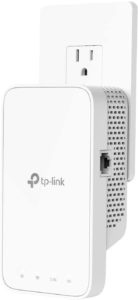
As you can see, you can get a decent wi-fi extender for less than $30. RE230 will not deliver the most amazing range or the highest possible speeds but, considering the price, it will deliver more than satisfying results. This extender is not recommended for plans other than Fios 200 Mbps. If you are paying for higher speeds (400 or Gigabit Connection), RE230 is probably not the best choice – it will work, but it won’t deliver those speeds.
RE230 is a dual-band extender (2.4/5 GHz) compatible with 802.11ac wireless standard. The advertised coverage is 1,200 ft2. It can handle up to 20 devices simultaneously. The max speed over a 2.4G band is 300 Mbps, while the max speed over 5G is 433 Mbps.
The unit is compatible with all routers. It can be used in repeater or access point mode. To set it up and monitor your network, you can use the Tether app (iOS/Android). Naturally, that’s not the only way to set up your extender. You can also use your internet browser and extender’s web interface (default IP – 192.168.0.254) or you can use the WPS button setup (works only if your router has a WPS button).
The extender is compatible with TP-Link’s OneMesh routers. It has a WPS button for quick setup and it features one fast Ethernet port. You can use this port to connect devices (TVs, laptops, gaming consoles, etc.) or to set up the extender in AP mode.
VIDEO TUTORIAL – How to Set Up TP-Link RE230 Using Tether app
2. Best Budget Wi-Fi Extender for Fios Router – NETGEAR EX2800
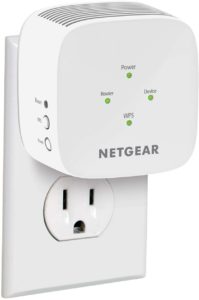
Like the previous extender, NETGEAR EX2800 is a great affordable option. The unit has the same specs as the previously reviewed TP-Link RE230, but it doesn’t have an Ethernet port and doesn’t support AP mode. In other words, this unit is just a repeater.
EX2800 can cover up to 1,200 ft2 and can handle up to 20 devices simultaneously. The extender is advertised as AC750. This tells you that the extender is compatible with the 802.11ac standard (WiFi5) and that the max speeds are 300 Mbps (2.4 GHz) and 450 Mbps (5 GHz).
The unit supports WPA2 wireless security protocol. To set it up, you can use the WPS button (quick setup) or the web user interface (mywifiext.net). NETGEAR Wi-Fi Analyzer app (Android devices only) will help you find the best location for your extender.
VIDEO TUTORIAL – How to Set Up NETGEAR EX2800
3. Best Wi-Fi Extender for Fios Router Under $100 – NETGEAR EX7000
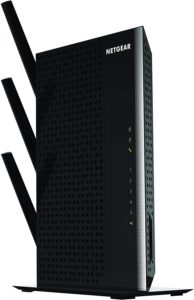
EX7000 is significantly more capable (and more expensive) than the previous two units. It provides better coverage, can deliver higher speeds, and handle more devices. It is also compatible with any router or gateway.
The unit is classified as AC1900. It is a dual-band extender that can cover up to 2,100 ft2 and can handle up to 35 devices. The max wireless speeds are 600 Mbps (2.4 GHz) and 1,300 Mbps (5 GHz).
The unit supports Smart Roaming and FastLane technologies. It also supports WPA2. It has 5 Ethernet ports for wired connection and can be used in two modes – repeater and AP.
VIDEO TUTORIAL – How to Set Up NETGEAR EX7000
4. Best Powerline Ethernet Extender for Fios Router – TP-Link TL-PA7017
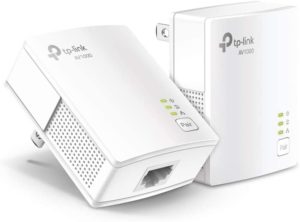
As discussed in the introduction, powerline extenders use different technology to extend your network – they use your existing electrical wiring. This specific model is more traditional – the receiver unit doesn’t have wi-fi – you can only connect devices to it via Ethernet cable (and you can only connect one device at a time).
The units included in this powerline kit have 1G Ethernet ports and, consequently, support data rates up to 1 Gbps.
The installation is quick and hassle-free – basically plug-n-play. You can secure your powerline network by pressing the pair button on both units.
VIDEO TUTORIAL – How to install TP-Link powerline Ethernet extender
This kit features a power-saving mode for reduced power consumption. Both units should be on the same circuit and they should both be plugged into wall outlets (you should avoid power strips, extension cords, UPS units, etc.). Also, you should avoid plugging in your kit next to a microwave and other devices that could cause interference.
5. Best Powerline Wi-Fi Extender for Fios Router – NETGEAR PLW1010
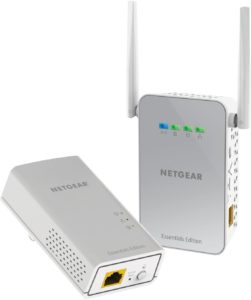
This NETGEAR powerline extender is the hybrid model. It’s still a kit – you have the sender and the receiver, but the receiver also has a built-in wi-fi transmitter. So, you can connect to this powerline extender wirelessly or via an Ethernet cable.
The sender and receiver units have Gigabit Ethernet ports, so they can (theoretically) support 1Gig speeds.
The receiver supports 802.11ac standard and it has a dual-band transmitter built inside. The installation is not complicated and takes just a few minutes. During the installation, try experimenting with different outlets – you will not get the same performance and wi-fi speeds with every outlet. For all the additional settings (wi-fi password and SSID changing, etc.), you can use this website – www.mywifiext.net.
To encrypt/secure your network, you just have to press the Security button on the receiver unit.
VIDEO TUTORIAL – How to Set Up NETGEAR PLW1010
6. Best Wi-Fi Extender for Fios Router Under $150 – TP-Link RE650
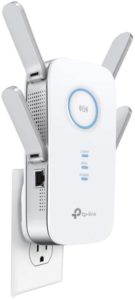
TP-Link RE650 is one of the most expensive and most capable TP-Link wi-fi extenders. It’s one of the most capable extenders on the market.
This unit supports the 802.11ac standard (WiFi5). It has four external antennas and one Gigabit Ethernet port. It can handle 30+ devices. The advertised coverage is up to 14,000ft2. The max wireless speeds are 800 Mbps (2.4 GHz) and 1,733 Mbps (5 GHz).
RE-650 supports MU-MIMO and beamforming. It has a capable 880 MHz dual-core processor and it can be used in two modes – repeater and AP.
The setup is quick and painless – you can use the WPS button setup (the quickest method), Tether app, or your web browser.
VIDEO TUTORIAL – How to Set Up TP-Link RE650
Best Wi-Fi Mesh Systems for Fios Router
7. Best Budget Wi-Fi Mesh System for Fios – TP-Link Deco S4
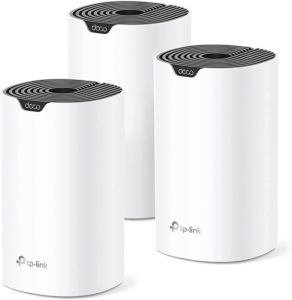
Deco S4 is a fantastic budget wi-fi mesh system. It can replace your Fios router or you can use the mesh router in AP mode. You will get three identical units – each can be used as a router.
Each Deco S4 unit has two Ethernet ports. Each also has a wi-fi transmitter compliant with the 802.11ac wireless communication standard. They are all dual-band. The advertised coverage is 5,500 ft2, which is pretty impressive. The units can be used for various home layouts.
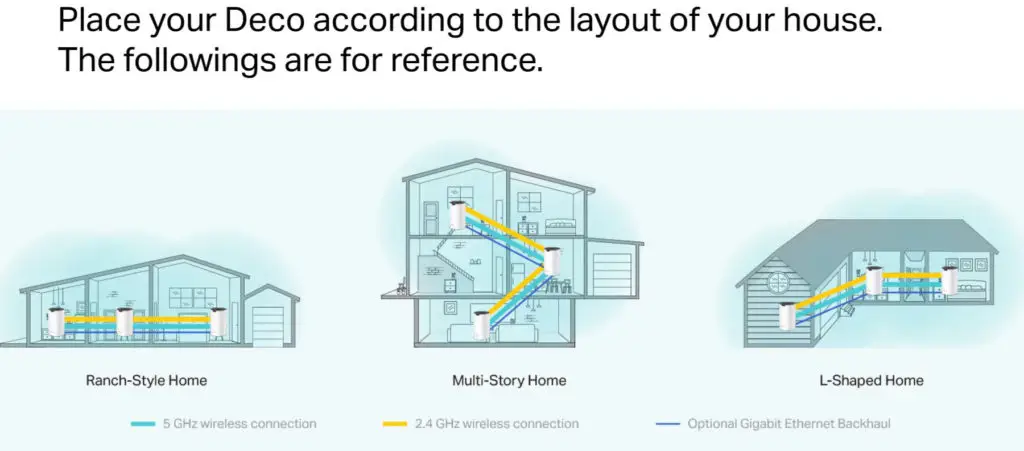
Deco S4 mesh system can handle up to 100 devices. The max wireless speeds are 300 Mbps (2.4 GHz) and 867 Mbps (5 GHz).
Thanks to the advanced Deco Mesh Technology, all three units will work together to create a reliable network with a single SSSID and password.
To set up your Deco mesh system, you should download and install the TP-Link Deco app (iOS/Android) – you just have to follow the instructions.
Deco S4 comes with the TP-Link’s HomeCare software and advanced parental controls. It supports WEP and WPA2 security protocols, as well as QoS and firewalls. Deco S4 is compatible with all the other Deco models, so you can combine them in the future.
VIDEO TUTORIAL – How to Set Up Deco S4 Mesh System
8. Best Wi-Fi Mesh System fir Fios Router Under $500 – Amazon eero Pro mesh
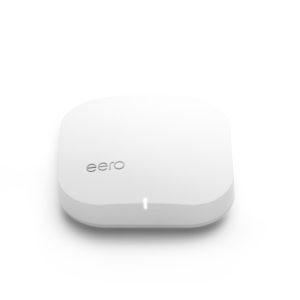
Eero is one of the most popular mesh systems. You have a few different versions of eero. For example, there’s a cheaper version that includes the main unit and two satellites ($320). Eero Pro Mesh system includes three units and each of these units can be used as the main router. Each has two Gigabit Ethernet ports. The system is priced at $500. This is not the most advanced system – you also have eero Pro 6 (it supports WiFi6).
Each eero Pro unit features a powerful quad-core processor and 512 MB RAM. The units are tri-band and deliver great coverage (up to 6,000 ft2). It is recommended to use eero Pro mesh system with internet plans up to 500 Mbps.
To install the system, monitor, and make adjustments to your network, you can use the eero app (iOS/Android).
VIDEO TUTORIAL – How to Set Up eero Pro Mesh System
9. Best Wi-Fi Mesh System for Fios Route Under $1,000 – NETGEAR Orbi RBK853
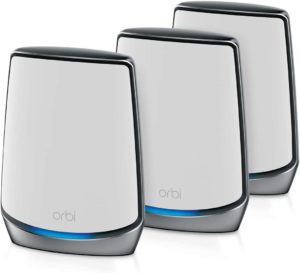
NETGEAR Orbi RBK853 is one of the most capable, most advanced, and most expensive mesh wi-fi systems for Fios. Orbi system is, by the way, the only mesh system approved by Fios. You can find instructions on how to install it on both – the official NETGEAR website and the official Verizon website.
The packaging includes two satellites and one router. They all look the same. The only difference is that the mesh router has one 2.5G WAN port. Each unit has four Gigabit Ethernet ports (12 ports in total). Each Orbi RBK853 unit has a quad-core 2.2 GHz processor and 1 GB RAM. Each unit has a tri-band wi-fi transmitter.
The system is rated as AX6000 – it supports 802.11ax wireless standard, while the max combined speed is 6000 Mbps (1,200 Mbps + 2,400 Mbps + 2,400 Mbps). The system can handle 100+ devices. The max coverage is 7,500 ft2 (2,500 ft2 per unit).
Orbi RB853 comes with the NETGEAR smart parental controls and all the advanced security features including WPA2-PSK and WPA3-PSK.
The installation is quick and simple – you just have to install the Orbi app (iOS/Android) and follow the instructions.
This concludes our selection of the best wi-fi extenders for Fios router. We hope this article and our suggestions helped you figure out what to look for, maybe even find the perfect extender/mesh system for your needs. For additional info about extenders, repeaters, and mesh systems for Fios router, read the FAQs.
FAQ
Q: How can I boost my Verizon Fios Wi-Fi signal?
A: There are at least two ways to boost your Verizon Fios Wi-Fi signal – you can try using an extender (in repeater or AP mode) or a mesh Wi-Fi system. Extenders are a cheaper option but will cut your speeds in half (or even more). They are a good choice if you’re on a budget and have just one or two dead zones. Mesh systems are much pricier than extenders. They don’t affect wireless speeds as much as extenders and, generally speaking, provide better wi-fi coverage and better overall performance than extenders.
Q: Do I have to use Fios range extenders? Can I use non-Fios extenders?
A: Buying a Fios extender is the most convenient solution. The installation is quick and hassle-free. More importantly, Fios extender is the perfect match for the Fios router and Fios TV ONE service. It enables seamless integration with your router and all the existing services.
However, using Fios extender is not your only option. If you’re looking for a cheaper solution, you can buy a wi-fi extender for Fios router. If you want even better wi-fi coverage and consistent speeds across your entire home, you can try using some third-party wi-fi mesh system.
Q: Can I use two Wi-Fi extenders at the same time?
A: Yes, you can use two wi-fi extenders at the same time. You shouldn’t connect the second extender to the first one, because the results won’t be great – both extenders should be connected to the router, and they should all have different wi-fi names. For example, if your dual-band router broadcasts two separate networks – Network 2.4G ad Network 5G, your first dual-band extender should broadcast networks – Network 2.4G_EXT and Network 5G_EXT, and your second extender should broadcast networks – Network 2.4G_EXT2 and Network 5G_EXT2.
Another thing to pay attention to is the distance between the extenders – you shouldn’t place them too close to each other because that could cause some unwanted interference. Placing them on the opposite ends of your home will not create interference.
Q: Where is the best place to put a Wi-Fi extender?
A: Placement of the extender is one of the most important things to think about when installing an extender. The extender is supposed to extend the reach of the signal to the dead zone, so it must not be installed where the dead zone is, especially if it’s used in repeater mode. If an extender is used as a repeater, then you should place it halfway between the router and your dead zone. That way, your extender will be able to pick up the signal from your router and push it further to your dead zone.
Today’s extenders often have indicators showing you when the extender is too far away (or too close) from the router, so you don’t have to experiment that much.
Q: What is the best Wi-Fi extender for Fios?
A: There can’t be just one right answer to this question because there are so many things to think about.
First of all, you don’t have just wi-fi extenders – you can also use Wi-Fi mesh systems, powerline adapters/extenders, or you can even install Wi-Fi access points. Access points don’t work in the same way as wi-fi extenders, but they will also provide you with a stable wi-fi connection across your entire home.
Second, the prices vary a lot – you can get a cheap wi-fi range extender for $20, while you can get a high-end extender for $100 or $150. Mesh systems cost even more.
If you need some suggestions, check out our selection of best wi-fi extenders for Fios router.
Q: How do I secure my Wi-Fi extender?
A: Wi-Fi extenders, just like our routers, create wi-fi networks. These networks are password-protected. Most wi-fi extenders support WPA2 wireless security protocols. The latest WiFi6 extenders support even more secure WPA3. Make sure to use one of these two protocols and try to create a complicated password. You can use the same password for your router and your extender, but you can also create different passwords for different networks. You should also change your router’s and your extender’s login credentials. For additional protection, you could also turn off Remote Management and limit WPS. Finally, keep your router’s and extender’s firmware up to date.
Q: Could a Wi-Fi extender improve Wi-Fi speed?
A: Wi-Fi extenders won’t improve your Wi-Fi speed – they will only extend the range. Wi-Fi extenders will, generally speaking, have a negative effect on your speeds.

Hey, I’m Jeremy Clifford. I hold a bachelor’s degree in information systems, and I’m a certified network specialist. I worked for several internet providers in LA, San Francisco, Sacramento, and Seattle over the past 21 years.
I worked as a customer service operator, field technician, network engineer, and network specialist. During my career in networking, I’ve come across numerous modems, gateways, routers, and other networking hardware. I’ve installed network equipment, fixed it, designed and administrated networks, etc.
Networking is my passion, and I’m eager to share everything I know with you. On this website, you can read my modem and router reviews, as well as various how-to guides designed to help you solve your network problems. I want to liberate you from the fear that most users feel when they have to deal with modem and router settings.
My favorite free-time activities are gaming, movie-watching, and cooking. I also enjoy fishing, although I’m not good at it. What I’m good at is annoying David when we are fishing together. Apparently, you’re not supposed to talk or laugh while fishing – it scares the fishes.
